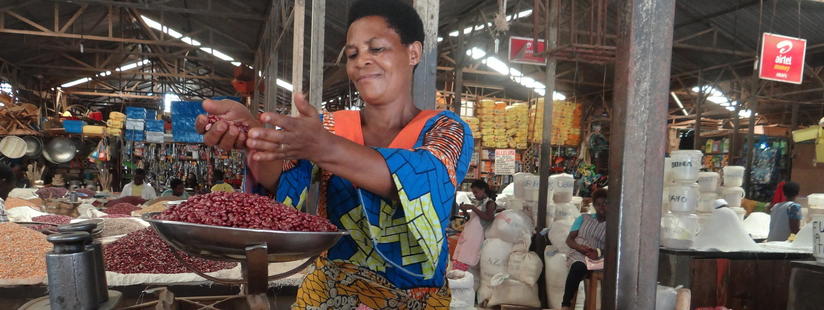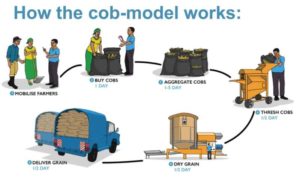Improved Post-Harvest Handling Techniques Increase Income for Rwanda’s Smallholder Farmers

Bean seller, Rwanda. Photo Credit: HarvestPlus
Post-harvest losses account for a 15-30 percent decrease in Rwandan agriculture productivity. Helping farmers reduce post-harvest loss is key to increasing household income. The Feed the Future Rwanda Hinga Weze Activity, a five-year USAID – funded project, is working with farmers and cooperatives to expand agriculture and improve post-harvest handling techniques.
Part 1 of Hinga Weze focuses on helping farmers achieve higher productivity levels for their crops through improved inputs and good agriculture practices. Once Rwandan smallholder farmers succeed in increasing their yields using improved growing methods, they turn to improving their post-harvest handling techniques to continue reaping the benefits of their crops. Hinga Weze’s part 2 focuses on improving farmers’ access to markets and post-harvest handling techniques.
As one of their partnerships, Hinga Weze works with Kumwe Harvest Ltd. – a private company that aggregates maize through a “cob-model” to sell to top tier food companies – to reduce post-harvest losses. Kumwe’s advanced processing techniques minimize the contamination level of aflatoxins, a secondary metabolite of toxic fungus, that contaminates stored grain. This process helps Kumwe sell to buyers while directly benefitting the farmers they purchase the maize from. Lower aflatoxin contamination results in improved health outcomes for the communities that consume the maize. Through their partnership with Hinga Weze, Kumwe was able to purchase professional grade drying and processing machinery to substantially increase the amount of maize purchased to 5,300 tons from 38,000 farmers in its first year of operation.

The cob-model offers a number of benefits for farmers:
- Increased Productivity: Kumwe purchases grain directly after harvest, reducing the amount of time farmers spend processing their harvest from six weeks down to only three days. The 5.5 weeks saved can be spent on other income-generating activities or preparing fields for the next planting.
- Faster payments to farmers: Farmers receive payment for their crops 1-2 days after the sale – weeks before they would normally receive payment. Maize harvest generally coincides with the payment of school fees. The income has the added bonus of facilitating opportunities for education.
- Improved access to markets: The cob-model creates the opportunity for smallholder farmers to enter markets with high-end national buyers, increasing their income from the sales compared to lower prices on the local market.
Besides maize, Hinga Weze is improving post-harvest handling processes for other produce like carrots. In the Western Province of Rwanda, Mukasine Mariza, a carrot farmer, struggled with the loss of a significant portion of her harvest to rot. When she sold her carrots, aggregators gave her a low price because of the carrots’ highly perishable nature. As Mukasine was losing hope, Hinga Weze offered a solution: A Zero Energy Cooling Chamber (ZECC). This simple technology is accessible for farmers to construct a vegetable storage unit without the need for advanced technology or electricity. It relies on the simple thermodynamics of bricks, water, and sand to maintain carrots at cool temperatures and thereby extend their shelf life by up to ten days. Through her cooperative, KOGIMUIN, Mukasine has access to a cooling facility that houses 300 crates of carrots, each carrying 15 kilograms. To date, the ZECC has handled 3,600 MT of carrots for the cooperative’s 55 members.
“I almost gave up farming, but now I no longer make losses. I save enough money for my children and can have them schooled properly.” Said Mukasine Mariza
Combined with trainings on good agricultural practices received from Hinga Weze, Mukasine has increased her yield by 50 percent to 4.5 tons/ha up from 3 tons/ha. Because Hinga Weze linked farmers to a cooperative of aggregators, she was able to negotiate prices up from 375,000 RWF (about $400) to 562,500 RWF (about $600) for the 4.5 MT yield.
In the coming months, Hinga Weze will be supporting smallholder farmers with improved drought-resistant seed varieties and training on good agricultural practices as part of the response to counter the effects of COVID-19 and help support food security in Rwanda.
Source: Agrilinks

